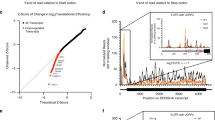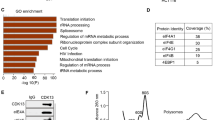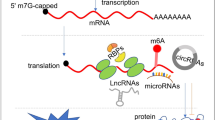Abstract
The tumor suppressor gene Pdcd4 (programmed cell death gene 4) has drawn considerable attention because its downregulation is involved in the development of several types of cancer. Because Pdcd4 interacts with the translation initiation factor eIF4A and inhibits its helicase activity, Pdcd4 has been implicated in the translational suppression of cellular mRNAs containing structured 5′-untranslated regions. However, Pdcd4’s role in translation regulation is still poorly understood, because only very few physiological Pdcd4 target mRNAs are known. By using a Pdcd4-deficient clone of the chicken B-cell line DT40, we have discovered that the mRNA of the A-myb proto-oncogene is a novel Pdcd4 target RNA whose translation is suppressed by Pdcd4. Interestingly, the inhibitory effect of Pdcd4 is independent of the Pdcd4–eIF4A interaction, but is dependent on an RNA-binding domain at the N terminus of Pdcd4 and on sequences located within the coding region of A-myb mRNA, indicating that Pdcd4 suppresses A-myb translation by a novel mechanism. Our data show that the Pdcd4 RNA-binding domain preferentially recognizes an RNA secondary structure element formed by the part of the A-myb coding region that mediates Pdcd4-dependent suppression. Previously, we have shown that Pdcd4 also suppresses the translation of the c-myb mRNA by a similar mechanism involving binding of Pdcd4 to RNA secondary structure formed by the c-myb coding region. Surprisingly, our data show that Pdcd4 exerts its inhibitory activity only when the target region of Pdcd4 in A-myb and c-myb mRNA is itself translated, consistent with a mechanism in which Pdcd4 suppresses translation by interfering with translation elongation. Taken together, our work reveals a novel mechanism by which Pdcd4 affects the translational of cellular RNAs. Furthermore, as c-myb and A-myb are members of the Myb proto-oncogene family whose deregulation has been implicated in tumorigenesis, inhibiting their translation might contribute to the tumor-suppressive activity of Pdcd4.
This is a preview of subscription content, access via your institution
Access options
Subscribe to this journal
Receive 50 print issues and online access
$259.00 per year
only $5.18 per issue
Buy this article
- Purchase on Springer Link
- Instant access to full article PDF
Prices may be subject to local taxes which are calculated during checkout







Similar content being viewed by others
References
Shibahara K, Asano M, Ishida Y, Aoki T, Koike T, Honjo T . Isolation of a novel mouse gene MA-3 that is induced upon programmed cell death. Gene 1995; 166: 297–301.
Cmarik JL, Min H, Hegamyer G, Zhan S, Kulesz-Martin M, Yoshinaga H et al. Differentially expressed protein Pdcd4 inhibits tumor promoter-induced neoplastic transformation. Proc Natl Acad Sci USA 1999; 96: 14037–14042.
Jansen AP, Camalier CE, Colburn NH . Epidermal expression of the translation inhibitor programmed cell death 4 suppresses tumorigenesis. Cancer Res 2005; 65: 6034–6041.
Chen Y, Knosel T, Kristiansen G, Pietas A, Garber ME, Matsuhashi S, et al. Loss of PDCD4 expression in human lung cancer correlates with tumour progression and prognosis. J Pathol 2003; 200: 640–646.
Afonja O, Juste D, Das S, Matsuhashi S, Samuels HH . Induction of PDCD4 tumor suppressor gene expression by RAR agonists, antiestrogen and HER-2/neu antagonist in breast cancer cells. Evidence for a role in apoptosis. Oncogene 2004; 23: 8135–8145.
Zhang H, Ozaki I, Mizuta T, Hamajima H, Yasutake T, Eguchi Y, et al. Involvement of programmed cell death 4 in transforming growth factor-beta1-induced apoptosis in human hepatocellular carcinoma. Oncogene 2006; 25: 6101–6112.
Mudduluru G, Medved F, Grobholz R, Jost C, Gruber A, Leupold JH, et al. Loss of programmed cell death 4 expression marks adenoma–carcinoma transition, correlates inversely with phosphorylated protein kinase B, and is an independent prognostic factor in resected colorectal cancer. Cancer 2007; 110: 1697–1707.
Wang Q, Sun Z, Yang H-S . Downregulation of tumour suppressor Pdcd4 promotes invasion and activates both β-catenin/TCF and AP-1-dependent transcription in colon carcinoma cells. Oncogene 2008; 27: 1527–1535.
Frankel LB, Christoffersen NR, Jacobsen A, Lindow M, Krogh A, Lund AH . Programmed cell death 4 (PDCD4) is an important functional target of the microRNA miR-21 in breast cancer cells. J Biol Chem 2008; 283: 1026–1033.
Lu Z, Liu M, Stribinskis V, Klinge CM, Ramos KS, Colburn NH . MicroRNA-21 promotes cell transformation by targeting the programmed cell death 4 gene. Oncogene 2008; 27: 4373–4379.
Asangani IA, Rasheed SA, Nikolova DA, Leupold JH, Colburn NH, Post S et al. MicroRNA-21 (miR-21) post-transcriptionally downregulates tumor suppressor Pdcd4 and stimulates invasion, intravasation and metastasis in colorectal cancer. Oncogene 2008; 27: 2128–2136.
Dorello NV, Peschiaroli A, Guardavaccaro D, Colburn NH, Sherman NE, Pagano M . S6K1- and betaTRCP-mediated degradation of PDCD4 promotes protein translation and cell growth. Science 2006; 314: 467–471.
Schmid T, Jansen AP, Baker AR, Hegamyer G, Hagan JP, Colburn NH . Translation inhibitor Pdcd4 is targeted for degradation during tumor promotion. Cancer Res 2008; 68: 1254–1260.
Yang HS, Matthews CP, Clair T, Wang Q, Baker AR, Li CC, et al. Tumorigenesis suppressor Pdcd4 down-regulates mitogen-activated proteinkinase kinase kinase kinase 1 expression to suppress colon carcinoma cell invasion. Mol Cell Biol 2006; 26: 1297–1306.
Leupold JH, Yang HS, Colburn NH, Asangani I, Post S, Allgayer H . Tumor suppressor Pdcd4 inhibits invasion/intravasation and regulates urokinase receptor (u-PAR) gene expression via Sp-transcription factors. Oncogene 2007; 26: 4550–4562.
Bitomsky N, Wethkamp N, Marikkannu R, Klempnauer K-H . siRNA-mediated knock-down of Pdcd4 expression causes up-regulation of p21(Waf1/Cip1) expression. Oncogene 2008; 27: 4820–4829.
Singh P, Marikkannu R, Bitomsky N, Klempnauer K-H . Disruption of the Pdcd4 tumor suppressor gene in chicken DT40 cells reveals its role in the DNA-damage response. Oncogene 2009; 28: 3758–3764.
Wedeken L, Singh P, Klempnauer K-H . Tumor suppressor protein Pdcd4 inhibits translation of p53 mRNA. J Biol Chem 2011; 286: 42855–42862.
Kumar N, Wethkamp N, Waters LC, Carr MD, Klempnauer K-H . Tumor suppressor proteins Pdcd4 interacts with Daxx and modulates the stability of Daxx and the Hipk2-dependent phosphorylation of p53 at serin 46. Oncogenesis 2013; 2: e37.
Böhm M, Sawicka K, Siebrasse JP, Brehmer-Fastnacht A, Peters R, Klempnauer K-H . The transformation suppressor protein Pdcd4 shuttles between nucleus and cytoplasm and binds RNA. Oncogene 2003; 22: 4905–4910.
Palamarchuk A, Efanov A, Maximov V, Aqeilan RI, Croce CM, Pekarsky Y . Akt phosphorylates and regulates Pdcd4 tumor suppressor protein. Cancer Res 2005; 65: 11282–11286.
Yang HS, Knies JL, Stark C, Colburn NH . Pdcd4 suppresses tumor phenotype in JB6 cells by inhibiting AP-1 transactivation. Oncogene 2003; 22: 3712–3720.
Bitomsky N, Böhm M, Klempnauer K-H . Transformation suppressor protein Pdcd4 interferes with JNK-mediated phosphorylation of c-Jun and recruitment of the coactivator p300 by c-Jun. Oncogene 2004; 23: 7484–7493.
Shiota M, Izumi H, Tanimoto A, Takahashi M, Miyamoto N, Kashiwagi E, et al. Programmed cell death protein 4 down-regulates Y-box binding protein-1 expression via a direct interaction with Twist1 to suppress cancer cell growth. Cancer Res 2009; 69: 3148–3156.
Yang HS, Jansen AP, Komar AA, Zheng X, Merrick WC, Costes S, et al. The transformation suppressor Pdcd4 is a novel eukaryotic translation initiation factor 4A binding protein that inhibits translation. Mol Cell Biol 2003; 23: 26–37.
Yang HS, Cho MH, Zacowicz H, Hegamyer G, Sonenberg N, Colburn N . A novel function of the MA-3 domains in transformation and translation suppressor Pdcd4 is essential for its binding to eukaryotic translation initiation factor 4A. Mol Cell Biol 2004; 24: 3894–3906.
LaRonde-LeBlanc N, Santhanam AN, Baker AR, Wlodawer A, Colburn NH . Structural basis for inhibition of translation by the tumor suppressor Pdcd4. Mol Cell Biol 2007; 27: 147–156.
Waters LC, Veverka V, Böhm M, Schmedt T, Choong PT, Muskett FW, et al. Structure of the C-terminal MA-3 domain of the tumour suppressor protein Pdcd4 and characterization of its interaction with eIF4A. Oncogene 2007; 26: 4941–4950.
Suzuki C, Garces RG, Edmonds KA, Hiller S, Hyberts SG, Marintchev A, et al. PDCD4 inhibits translation initiation by binding to eIF4A using both its MA3 domains. Proc Natl Acad Sci USA 2008; 105: 3274–3279.
Chang JH, Cho YH, Sohn SY, Choi JM, Kim A, Kim YC, et al. Cyrstal structure of the eIF4A–PDCD4 complex. Proc Natl Acad Sci USA 2009; 106: 3148–3153.
Loh PG, Yang HS, Walsh MA, Wang Q, Wang X, Cheng Z et al. Structural basis for translational inhibition by the tumour suppressor Pdcd4. EMBO J 2009; 28: 274–285.
Singh P, Wedeken L, Waters LC, Carr MD, Klempnauer K-H . Pdcd4 directly binds the coding region of c-myb mRNA and suppresses its translation. Oncogene 2011; 30: 4864–4873.
Kumarswamy R, Volkmann I, Thum T . Regulation and function of miRNA-21 in health and disease. RNA Biol 2011; 8: 706–713.
Clappier E, Cuccuini W, Kalota A, Crinquette A, Cayuela JM, Dik WA, et al. The C-MYB locus is involved in chromosomal translocation and genomic duplications in human T-cell acute leukemia (T-ALL), the translocation defining a new T-ALL subtype in very young children. Blood 2007; 110: 1251–1261.
Lahortiga I, De Keersmaecker K, Van Vlierberghe P, Graux C, Cauwelier B, et al. Duplication of the MYB oncogene in T cell acute lymphoblastic leukemia. Nat Genet 2007; 39: 593–595.
Drabsch Y, Hugo H, Zhang R, Dowhan DH, Miao YR, Gewirtz AM, et al. Mechanism of and requirement for estrogen-regulated MYB expression in estrogen-receptor-positive breast cancer cells. Proc Natl Acad Sci USA 2007; 104: 13762–13767.
Biroccio A, Benassi B, D'Agnano I, D'Angelo C, Buglioni S, Mottolese M, et al. c-Myb and Bcl-x overexpression predicts poor prognosis in colorectal cancer: clinical and experimental findings. Am J Pathol 2001; 158: 1289–1299.
Persson M, Andrén Y, Mark J, Horlings HM, Persson F, Stenman G . Recurrent fusion of MYB and NFIB transcription factor genes in carcinomas of the breast and head and neck. Proc Natl Acad Sci USA 2009; 106: 18740–18744.
Ramkissoon LA, Horowitz PM, Craig JM, Ramkissoon SH, Rich BE, Schumacher SE, et al. Genomic analysis of diffuse pediatric low-grade gliomas identifies recurrent oncogenic truncating rearrangements in the transcription factor MYBL1. Proc Natl Acad Sci USA 2013; 110: 8188–8193.
Zhang J, Wu G, Miller CP, Tatevossian RG, Dalton JD, Tang B, et al. Whole-genome sequencing identifies genetic alterations in pediatric low-grade gliomas. Nat Genet 2013; 45: 602–612.
Schlichter U, Kattmann D, Appl H, Miethe J, Brehmer-Fastnacht A, Klempnauer K-H . Identification of the myb-inducible promoter of the chicken Pdcd4 gene. Biochim Biophys Acta 2001; 1520: 99–104.
Schlichter U, Burk O, Worpenberg S, Klempnauer K-H . The chicken Pdcd4 gene is regulated by v-Myb. Oncogene 2001; 20: 231–239.
Appl H, Klempnauer K-H . Targted disruption of c-myb in the chicken pre B-cell line DT40. Oncogene 2002; 21: 3076–3081.
Wedeken L, Ohnheiser J, Hirschi B, Wethkamp N, Klempnauer K-H . Association of tumor suppressor protein Pdcd4 with ribosomes is mediated by protein–protein and protein–RNA interactions. Genes Cancer 2010; 1: 293–301.
Ercikan-Abali EA, Banerjee D, Waltham MC, Skacel N, Scotto KW, Bertino JR . Dihydrofolate reductase protein inhibits its own translation by binding to dihydrofolate reductase mRNA sequences within the coding region. Biochemistry 1997; 36: 12317–12322.
Lin X, Parsels LA, Voeller DM, Allegra CJ, Maley GF, Maley F, et al. Characterization of a cis-acting regulatory element in the protein coding region of thymidylate synthase mRNA. Nucleic Acids Res 2000; 28: 1381–1389.
Zhang Y, Yang S, Liu M, Song C, Wu N, Ling P, et al. Interaction between thymidylate synthase and its cognate mRNA in zebrafish embryos. PLoS One 2010; 5: e10618.
Prechtel AT, Chemnitz J, Schirmer S, Ehlers C, Langbein-Detsch I, Stülke J, et al. Expression of CD83 is regulated by HuR via a novel cis-active coding region element. J Biol Chem 2006; 281: 10912–10925.
Perez-Leal O, Barrero CA, Clarkson AB, Casero RA Jr ., Merali S . Polyamine-regulated translation of spermidine/spermine-N1-Acetyltransferase. Mol Cell Biol 2012; 32: 1453–1467.
Hogan DJ, Riordan DP, Gerber AP, Herschlag D, Brown PO . Diverse RNA-binding proteins interact with functionally related sets of RNAs, suggesting an extensive regulatory system. Plos Biol 2008; 6: e255.
Hafner M, Landthaler M, Burger L, Khorshid M, Hausser J, Berninger P, et al. Transcriptome-wide identification of RNA-binding protein and microRNA target sites by PAR-CLIP. Cell 2010; 141: 129–141.
Baltz AG, Munschauer M, Schwanhäusser B, Vasile A, Murakawa Y, Schueler M, et al. The mRNA-bound proteome and its global occupancy profile on protein-coding transcripts. Mol Cell 2012; 46: 674–690.
Brümmer A, Kishore S, Subasic D, Hengartner M, Zavolan M . Modeling the binding specificity of the RNA-binding protein GLD-1 suggests a function of coding region-located sites in translational repression. RNA 2013; 19: 1317–1326.
Foos G, Grimm S, Klempnauer K-H . The chicken A-myb protein is a transcriptional activator. Oncogene 1994; 9: 2481–2488.
Golay J, Loffarelli L, Luppi M, Castellano M, Introna M . The human A-myb protein is a strong activator of transacription. Oncogene 1994; 9: 2469–2479.
Sleeman JP . Xenopus A-myb is expressed during early spermatogenesis. Oncogene 1993; 8: 1931–1941.
Klempnauer K-H, Bonifer C, Sippel AE . Identification and characterization of the protein encoded by the human c-myb proto-oncogene. EMBO J 1986; 5: 1903–1911.
Acknowledgements
We thank J Golay for the human A-Myb expression vector. This work was supported by a grant from the Deutsche Krebshilfe and the Deutsche Forschungsgemeinschaft. AB and PS were supported by fellowships from the Graduate School of Chemistry (GSC-MS) at the University of Münster.
Author information
Authors and Affiliations
Corresponding author
Ethics declarations
Competing interests
The authors declare no conflict of interest.
Rights and permissions
About this article
Cite this article
Biyanee, A., Ohnheiser, J., Singh, P. et al. A novel mechanism for the control of translation of specific mRNAs by tumor suppressor protein Pdcd4: inhibition of translation elongation. Oncogene 34, 1384–1392 (2015). https://doi.org/10.1038/onc.2014.83
Received:
Revised:
Accepted:
Published:
Issue Date:
DOI: https://doi.org/10.1038/onc.2014.83
This article is cited by
-
The molecular basis of translation initiation and its regulation in eukaryotes
Nature Reviews Molecular Cell Biology (2024)
-
PDCD4 controls the G1/S-phase transition in a telomerase-immortalized epithelial cell line and affects the expression level and translation of multiple mRNAs
Scientific Reports (2020)
-
Nuclear PDCD4 Expression Defines a Subset of Luminal B-Like Breast Cancers with Good Prognosis
Hormones and Cancer (2020)
-
IBTK contributes to B-cell lymphomagenesis in Eμ-myc transgenic mice conferring resistance to apoptosis
Cell Death & Disease (2019)
-
RNA-binding protein HuR sequesters microRNA-21 to prevent translation repression of proinflammatory tumor suppressor gene programmed cell death 4
Oncogene (2016)



